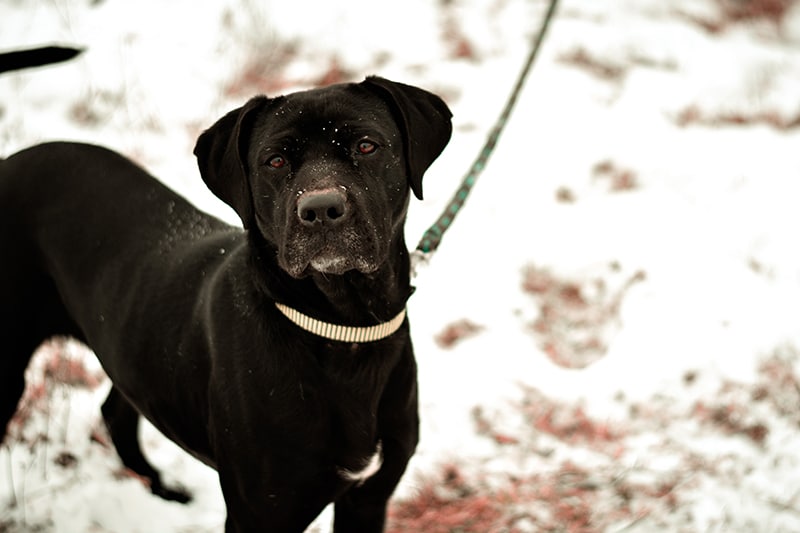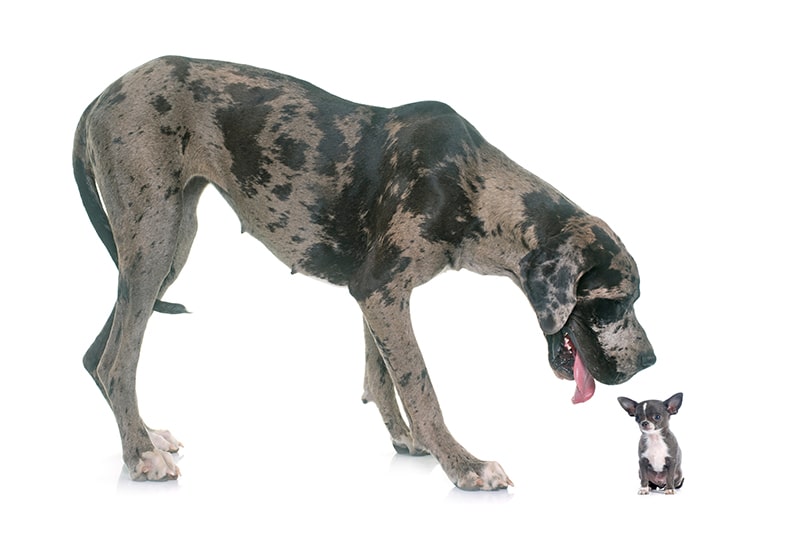The Great Dane Dalmatian mix also known as the the Great Dal or Great Dalmatian is an absolute unit of a dog. Despite their enormous size, these spotted companions make great working dogs, as they are high-energy and tend to be very friendly, loving and intelligent animals.
The Great Dalmatian will likely have the height of a Great Dane and the spotted appearance of a Dalmatian, and because of this unique appearance, they’re easily distinguished as a breed. Despite being large in size, the Great Dal does not necessarily require excessive exercise and is likely to be a very calm addition to your household.
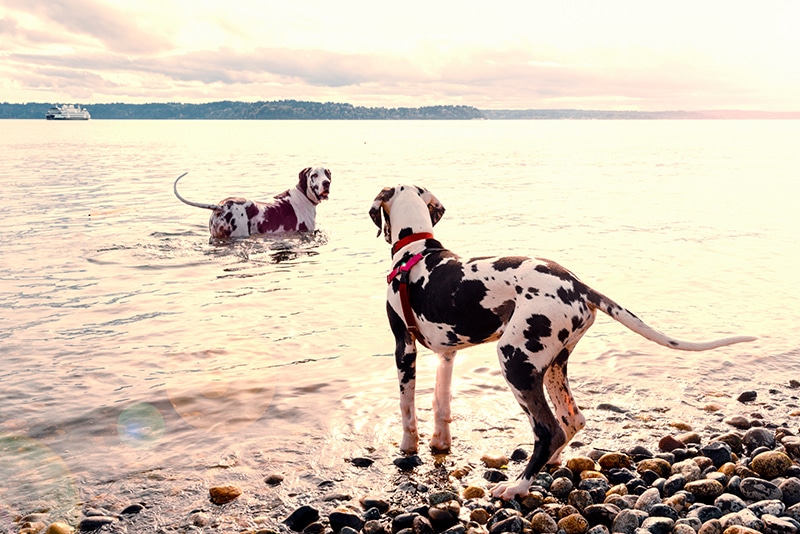
Great Dane Dalmatian Mix – At a Glance
| Weight: | 60-100 pounds |
| Height: | 19-32 inches |
| Lifespan: | 8-13 years |
| Coat Colors: | spotted black/white |
| Temperament: | fearless, loyal, alert, intelligent and social |
| Most Suitable For: | Families with/without kids, active owners, experienced dog owners |
What Does a Great Dane Dalmatian Mix Look Like?
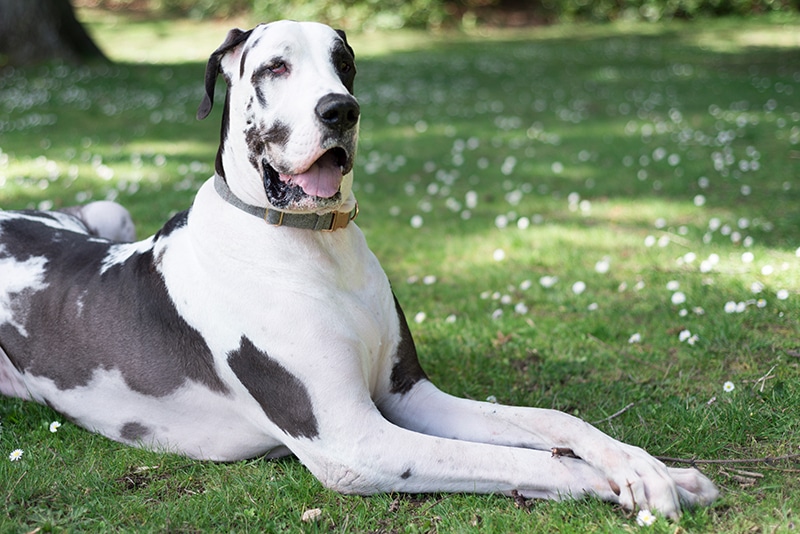
A Great Dane Dalmatian mix will inherit both of its size traits from its already-tall parent genes. It’s no secret how large a Great Dane is – the Dalmatian isn’t quite that size but is still of considerable height.
Expect your Great Dane Dalmatian mix to grow to a maximum height of between 26 and 30 inches tall and will weigh in at a whopping 80-115lbs. Most of the coloration of the Great Dane Dalmatian mix will come from the Dalmatian, so you can expect a white with black spots color pattern, or even a brown with white spot coloration if their genes are predominantly Great Dane. As with so much cross-breeding, it all depends on the genes of your specific dog.
Are you looking for a way to treat your furry friend? Sign up for our newsletter for a chance to win a free month of Barkbox!
The History of the Great Dane Dalmatian Mix:
One of the important things to note is that Dalmatian Great Dane mixes are not commonly bred as hybrid dogs. Though the exact historical details of the cross-breeding between the Dalmatian and the Great Dane are murky, it is believed to have been created to produce a large, tall dog that was also friendly, calm, and good with people.
Great Dane History
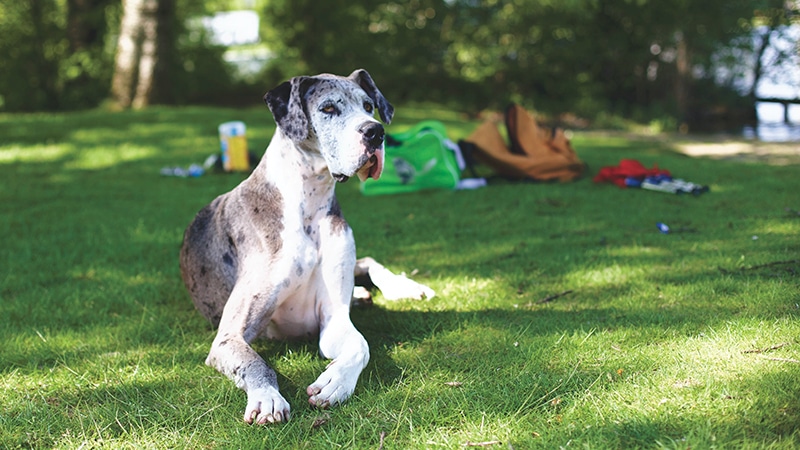
The history of the Great Dane, despite its name, dates back to Germany and is thought to be around 400 years old. The Great Dane was originally bred as a working dog, mainly used for hunting – though the dog eventually gained popularity among the German aristocracy of the time (mostly due to its large size) and became less of a hunting dog and more of a pet of status. They were used as protection dogs for German aristocrats’ estates.
How Popular Are Great Danes in the United States?
The Great Dane has been hovering steadily around the twentieth most-popular dog in the United States in recent years and finished 2021 in 17th place in the American Kennel Club’s list of most popular breeds. They are particularly popular among those with larger spaces, both indoor and outdoor – due to their size – and those with families due to their protective nature and imposing look. Though, they are generally very friendly and good with children.
Who Are Great Danes a Good Dog For?
The Great Dane is mostly suitable right across the board – though its large size and high metabolic rate suggest that it will need plenty of exercise throughout its life. Anyone seeking to adopt or purchase a Great Dane pup should be wary of its sizing and ensure that they have adequate space to accommodate such a large dog.
How Did Great Danes Come About?
Great Danes were first a part of the German aristocracy, as a hunter/gatherers of wild boar and as a protective measure for their large countryside estates. It’s unclear from research exactly when Great Danes landed in America – though it is no wonder – with our myriad wide open spaces, it’s easy to see how a Great Dane would be right at home in places such as the Midwest.
When Did We First Cross-Breed Great Danes?
The Great Dane itself is a crossbreed between the Irish Wolfhound and an English mastiff – one for its speed and size, the other for its intellectual fortitude. There’s a similar mix going on with the Great Dane Dalmatian mix, as Dalmatians are known to be incredibly intelligent animals, with the Great Dane making up the size and strength portion of the cross.
However, the modern history of crossbreeding the Great Dane likely began in the 1990s and early 2000s, as crossbreeding became very popular throughout the United States. Some of the most popular Great Dane crosses include:
- Corgi Great Dane Mix (Cordane)
- Boxer Great Dane Mix (Boxadane)
- Great Dane Cane Corso Mix (Great Corso)
- Great Dane Husky Mix (Great Danesky)
- Great Dane Chihuahua Mix (Great Chi)
Dalmatian History
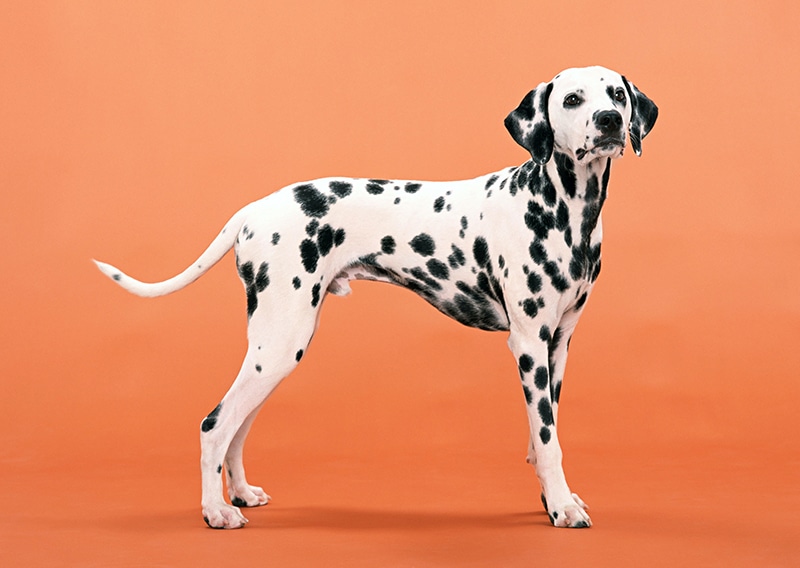
The Dalmatian is another mysterious dog breed, though it is named after the Croatian coastline region of Dalmatia, off the Adriatic Sea. The Dalmatian itself is thought to have been a creation of mixing certain types of Pointers, with a spotted-coat Great Dane. They have their origins as hunting dogs but have also been used in combat roles during the Great War and Second World War – mostly due to their speed, stamina, and agility.
How Popular Are Dalmatians in the United States?
Dalmatians aren’t the most popular dog in the country, that’s for sure – ranking at 49th in last year’s dog popularity rankings by the American Kennel Club. Though they do have a history of being the pets of many an American firehouse, their history with firehouses dates back to the 1700s when they were guardians of carriages.
Who Are Dalmatians A Good Dog For?
Like the Great Dane, Dalmatians are the perfect dogs for just about anyone. Their affable nature, loving demeanor, and their protective pedigree make them the perfect house pet. Though they’re not small dogs by any means, they’re unlikely to require the same amount of space as the Great Dane. However, a Dalmatian will still require plenty of exercises.
How Did Dalmatians Come About?
First bred in Europe centuries ago, the Dalmatian has taken on lots of roles throughout the centuries, hailing from the Adriatic Coast and Croatia, it has been exported across Europe and the New World in 1700, taking on roles as guard dogs, war dogs, firehouse pets and eventually winding up as our beloved house pets that they are today.
How Did We First Cross-Breed Dalmatians?
The time of early cross-breeding of the Dalmatian is unclear, but in the present-day, Dalmatians are crossed with multiple breeds of dogs. This practice began sometime in the 1990s and early 2000s, due to the popularity of crossbreeding in the United States.
Some of the most popular Dalmatian crosses include:
- Dalmatian Husky Mix (Dalusky)
- Corgi Dalmatian Mix (Cormatian)
- Dalmatian German Shepherd Mix (Germatian)
- Dalmatian Golden Retriever Mix (Goldmatian)
- Dalmatian Pitbull Mix (Pitmatian)
What is The Temperament of a Great Dane Dalmatian Mix?
The Great Dane Dalmatian mix brings together two dogs that have matching temperaments. Both are fiercely loyal, independent dogs, with a social side. They’re usually very gentle with children and aloof with most strangers, making them OK to bring out into the public. They can be relatively energetic – mixing the calm demeanor of the Great Dane with the high energy of the Dalmatian. In general, these dogs provide a calming temperament and are unlikely to be aggressive.
Are Great Dane Dalmatian Mixes Friendly?
In general, Great Dane Dalmatian are very friendly dogs, though Great Danes have a reputation for being a bit reserved, so if your dog gets more of the Great Dane genes they may be more aloof than some other crosses.
They are great family dogs since they love unconditionally and crave your attention. Like any dog they also can get separation anxiety since they don’t like being left alone for long periods of time.
They get along great with kids and other animals so this is a perfect fit if you’re looking to add additional pets (or babies) down the line to your family!
Are Great Dane Dalmatian Mixes Easy to Train?
We know that both of the parent breeds were bred for hunting at one point in their genealogical history which makes them both relatively easy to train. Any Great Dane Dalmatian mix will inherit those traits and should be straight forward to train although they do have a reputation for being a bit stubborn.
The best method for training your Great Dal is to start early and to use positive reinforcement. These dogs are typically very food motivated so you can reward them with treats when they do the right thing which will help the training process.
You want to avoid yellowing at your pup as much as possible since they don’t react well to that. They are responsive to praise and rewarding when they behave the way you’d like them to.
How Big Can the Great Dane Dalmatian Mix Get?
The Great Dane Dalmatian mix usually gets most of its size from the Great Dane parent gene. Depending on how much they have will determine their size but you can expect them to weigh in around 100 pounds on average but can get all the way up to 160lbs. Both the Great Dane and the Dalmatian are quite tall dogs, you can expect them to reach around 32 inches in height.
It’s important to understand the sheer size of this dog since you’ll need to be able to train and control them in certain situations.
Similar Sized Breeds
The Great Dane is among the world’s largest dog breeds – cross that with an already tall Dalmatian, and you’re going to be looking at the upper end of the dog spectrum to find a similarly sized breed. The Doberdane is another cross – between a Great Dane and a Doberman, and a Great Bernard – a cross between a Great Dane and Saint Bernard. Beyond that, you’re unlikely to find anything near the size of the Great Dane.
Does a Great Dane Dalmatian Mix Shed?
In short, yes. The Great Dane Dalmatian does shed consistently throughout the year, though as a short-haired dog, it’s nothing you can’t manage with a vacuum and a good weekly or bi-weekly brush.
How Much Exercise Does a Great Dane Dalmatian Mix Require?
The Great Dane Dalmatian does require a fair bit of exercise, as both breeds were bred to run. Make sure you have adequate yard space or a large field for the dog to run in.
Since they are high energy dogs, it’s important to make sure you walk them at least once a day. But make no mistake they enjoy their relaxation and will be part-time couch potatoes as well.
How Long Does a Great Dane Dalmatian Mix Live?
The Great Dane sadly tends to live only 6-8 years due to their size and health issues, but the Dalmatian has slightly longer longevity of 12-14 years.
Therefore, we can assume that the average lifespan of the Great Dane Dalmatian is likely to be around 10 years.
What Health Conditions Does a Great Dane Dalmatian Mix Have?
Unfortunately, the Great Dane Dalmatian can come with a variety of health problems, including:
Though, in general, the dog’s health will depend on its lifestyle and diet.
Where Can You Find a Great Dane Dalmatian Mix For Sale?
Before looking at breeders, you should try to find a Dalmatian Great Dane Mix for adoption at a local shelter since there just so many dogs in local shelters that need help. While it may be difficult to find a Great Dane Dalmatian mix at shelters it could be beneficial to check all local adoptions first before contacting a breeder.
You’ll be paying a whole lot less for adoption and will be giving a dog a loving home.
How Much Does a Great Dane Dalmatian Mix Cost?
Much of the cost associated with the Great Dane Dalmatian will depend on the breeder you choose and the location. But, you can expect to pay anywhere from $400 to $2000 for a Great Dane Dalmatian mix.
It’s important that if you go the breeder route that you do your research on the quality of the breeder you’re buying from. They should be willing to provide you with health certificates and answer any questions you may have about the history and health of their dogs.
Is the Great Dane Dalmatian Mix The Right Breed For You?
The Great Dane Dalmatian mix is the perfect choice for any homeowner with plenty of space, indoors and outdoors. Their loyal companionship and overall friendliness toward other dogs and children make them great social animals as well. The biggest consideration when choosing to adopt this breed is whether or not you have the bank balance to feed them (they have a high metabolism and therefore large appetites), and if you have the necessary space to give them the amount of exercise and freedom their breed deserves.

